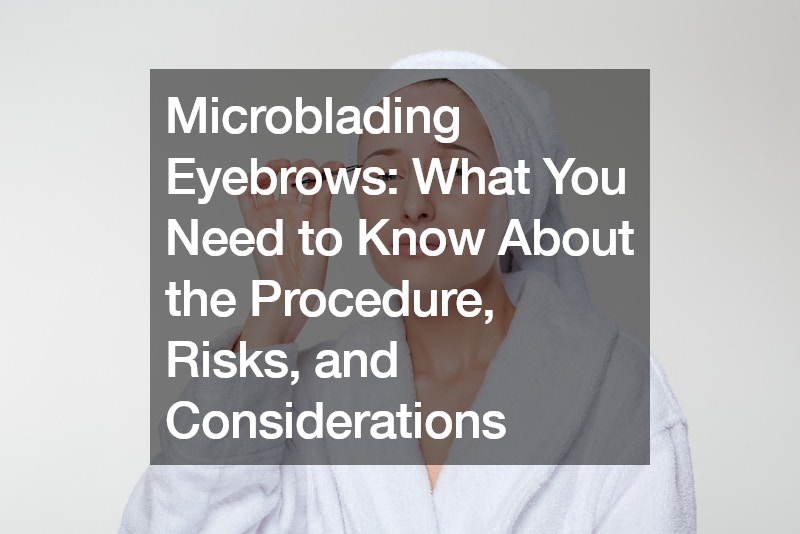Disclaimer: Mladysrecords. This site provides fashion and lifestyle content for informational purposes only.
Microblading has risen to prominence as a favored method for achieving fuller, well-defined eyebrows. This semi-permanent cosmetic procedure, resembling a tattoo, involves depositing pigment into the skin using a handheld tool. While microblading offers an appealing solution, it’s imperative to grasp the intricacies and potential risks associated with this eyebrow enhancement technique.
Understanding Microblading:
Microblading distinguishes itself from traditional tattooing by using a sterile handheld tool to deposit pigment into the superficial layers of the skin. The stroke-like effect creates a natural-looking eyebrow appearance.
However, the superficial placement contributes to a faster fading process compared to traditional tattoos, making microblading semi-permanent.
Choosing Microblading for Thinning Eyebrows:
Microblading emerges as a preferred choice for individuals dealing with eyebrow hypotrichosis, a condition characterized by thinning or loss of eyebrows. It offers a practical solution for those seeking to address the aesthetic and emotional impact of sparse eyebrows. Despite its popularity, it is essential to delve into potential complications associated with the procedure.
Potential Complications:
A significant risk associated with microblading is the potential development of allergies to the pigments used. Allergic reactions can manifest immediately or gradually over time, posing discomfort and complications. This aspect is particularly crucial for individuals with a history of skin sensitivities or allergies.
Scarring is another concern, especially for individuals prone to keloids or thick scars. Any procedure causing injury to the skin, whether microblading or a traditional tattoo, can exacerbate scarring issues. Individuals considering microblading should carefully weigh these potential complications against the desire for enhanced eyebrows.
Regulatory Variations Across States:
Regulation of microblading varies across states, adding complexity to the decision-making process. In Texas, for example, microblading falls under the jurisdiction of the Texas Health and Human Services Department. Compliance involves a fee, demonstrating adherence to hygiene regulations and meeting age requirements. However, the lack of consistency in regulating practitioners’ skill sets and training underscores the need for thorough research before selecting a microblading professional.
Skin Conditions and Considerations:
Microblading may not be suitable for individuals with specific skin conditions. Conditions exhibiting Koebnerization, where trauma to the skin induces rashes, can complicate the procedure. Psoriasis, a condition known for Koebnerization, may flare up in the eyebrow area post-microblading.
Additionally, individuals with a history of herpes simplex virus breakouts should approach microblading with caution. The procedure can trigger viral outbreaks, emphasizing the importance of consulting healthcare providers before undergoing microblading.
Aftercare Essentials:
Maintaining the results of microblading requires meticulous aftercare. Coating the eyebrows with Vaseline or petroleum jelly before using skincare products helps prevent pigment migration and fading. Sunscreen is non-negotiable to shield brows from harmful ultraviolet radiation. Individuals considering microblading should be prepared for lifestyle adjustments, avoiding facial treatments like LED light or steam that can accelerate fading.
Removal Challenges and Considerations:
While marketed as a semi-permanent solution, microblading removal is a challenging process. Unlike traditional tattoos that respond more favorably to laser removal, microblading’s unique fading mechanism poses challenges. The use of certain lasers can lead to complications, making removal a complex and potentially less satisfying process.
Cultural and Personal Implications:
Beyond the technicalities and potential risks, microblading, much like traditional tattooing, carries cultural and personal significance. For many, it is a form of self-expression, and the decision to undergo the procedure should be deeply personal and well-considered. Understanding the permanence, even in the face of fading, is crucial for those exploring microblading.
Informed Decision-Making:
In conclusion, microblading eyebrows can be a transformative experience for those seeking enhanced aesthetics and confidence. However, the decision to undergo this procedure should be rooted in thorough research, an understanding of individual health considerations, and a clear awareness of potential complications. Informed decision-making, coupled with stringent aftercare practices, ensures that individuals can enjoy the benefits of microblading while minimizing associated risks.
Long-Term Effects and Aging:
As individuals age, the skin undergoes natural changes that can impact the appearance of microbladed eyebrows. Understanding how the procedure interacts with the aging process is crucial for those considering microblading as a long-term solution. Factors such as skin elasticity, changes in pigmentation, and overall facial aging can influence the results over time.
Financial Considerations:
Microblading is an investment, and individuals should consider the financial aspects before committing to the procedure. While the initial cost may be a primary concern, factoring in potential touch-up sessions, aftercare products, and the long-term commitment of maintaining microbladed eyebrows is essential for a comprehensive financial evaluation.
Conclusion:
While microblading offers a promising solution for achieving defined and fuller eyebrows, individuals must approach the decision with a thorough understanding of the procedure’s complexities and potential risks. Considering factors such as regulatory variations, skin conditions, aftercare, removal challenges, long-term effects, financial implications contributes to an informed and holistic decision-making process. Ultimately, the journey to enhanced eyebrows should align with individual preferences, lifestyle, and a commitment to overall well-being.
.


